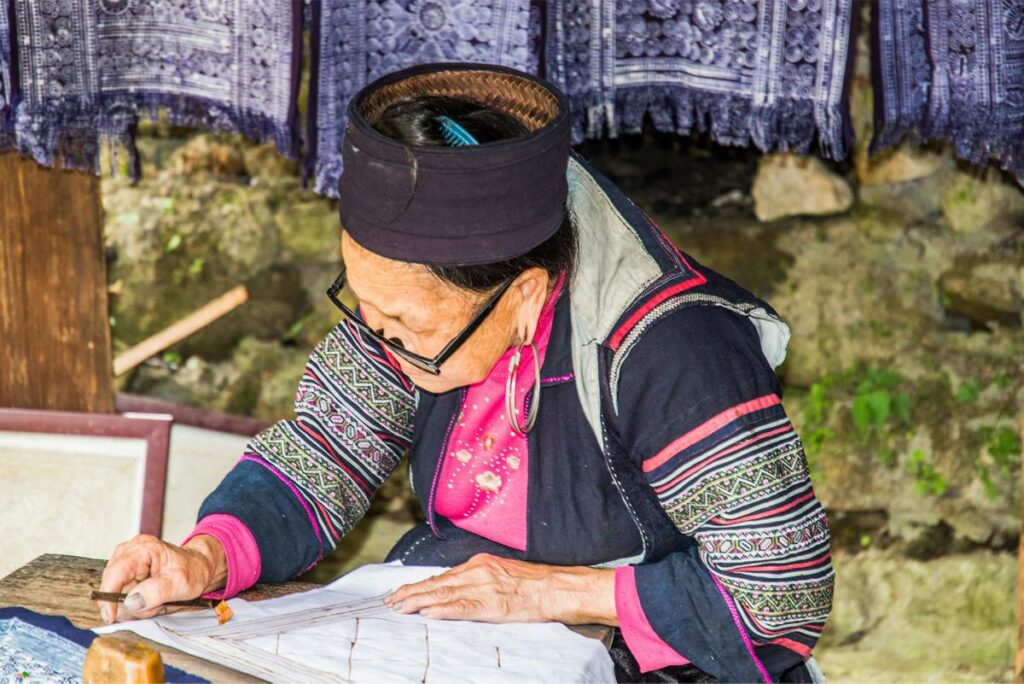What is Cat Cat Village?
Sapa is known for its stunning rice terraces and diverse ethnic minority cultures, especially the Hmong and Dao communities who live in small villages across the surrounding mountains. These minority groups have shaped the landscape over generations—carving the terraces and preserving their unique customs and crafts.

Cat Cat Village is one of those villages, but unlike others, it no longer functions as a real, living community. The area was purchased by a tourism company and turned into a kind of open-air museum meant to introduce visitors to minority culture in a highly curated way. It’s designed for easy access from Sapa town and includes staged traditional houses, souvenir shops, and scenic photo spots.
There is an entrance fee to visit, and while the surroundings are beautiful, the experience is more theatrical than authentic. Cat Cat offers a simplified version of local life—ideal for those who want a taste of minority culture without venturing too far, but not representative of how people in the region actually live. The rest of this guide will help you understand what to see there, how to get there, and why many travelers choose to visit more authentic villages instead.
How to get to Cat Cat Village
Cat Cat Village is located just a few kilometers from the center of Sapa, making it one of the most accessible villages in the region. First, of course, you’ll need to get to Sapa itself — read our separate guide: How to get from Hanoi to Sapa. Once you’re in town, here are the main ways to reach Cat Cat Village:
Walk from Sapa (Short Hike)
The most popular option is walking. Follow one of Sapa’s main streets heading downhill until you reach the ticket booth and entrance to Cat Cat Village. From the center of town, it’s about a 20–30 minute walk with scenic views of the Muong Hoa Valley, rice terraces, and occasional grazing buffalo along the way. The path is paved and relatively easy, though steep in some parts.
Take a taxi
Taxis from Sapa to Cat Cat take around 5 minutes and cost approximately 40,000–60,000 VND one way. For convenience, you can ask the driver to wait and bring you back afterward—many local drivers are open to this arrangement. Just agree on the price beforehand.
Hire a private car with driver
If you’re planning a larger itinerary—such as combining Cat Cat Village with nearby attractions like Tram Ton Pass or waterfalls—you can hire a private car with driver. This gives you flexibility and a fixed price for a half or full day, rather than using a metered taxi. It’s not practical for Cat Cat alone but works well for multi-stop trips.
Explore beyond Cat Cat with a private car
We can arrange a car with driver for your visit to Cat Cat Village—or help plan a custom route to explore more authentic villages and scenic spots around Sapa.
Rent a motorbike
Motorbike rental is another option if you’re an experienced rider. The road to Cat Cat is short, paved, and generally safe with light traffic—nothing like the chaos of Hanoi. You can read our full guide: Renting and driving a motorbike in Sapa. Always wear a helmet and only choose this option if you’re confident riding in mountain areas.
What to see & do at Cat Cat Village
Once you reach the entrance of Cat Cat Village, you’ll need to buy a ticket (currently 50,000 VND). The price includes access to the village and a basic paper map to follow the walking route. Here’s what you can expect to see along the way:
1. Recreated Hmong village homes
Several houses are open to visitors, offering a look inside traditional-style Hmong homes. These “exhibition houses” aren’t original dwellings but are meant to give an introduction to local architecture and lifestyle. Inside you’ll find typical features like wooden beams, central hearths, and simple sleeping spaces. While not fully authentic, they help provide context about Hmong culture.
2. Traditional crafts and textile displays

Cat Cat is known for showcasing traditional Hmong crafts, especially brocade weaving and indigo dyeing. Along the walking path, you’ll see local women working behind looms, dyeing fabrics, and embroidering colorful patterns inspired by nature. Though much of this is set up for visitors, the techniques and materials reflect genuine traditions still used in the region.
3. Souvenir shops and handicrafts

There are many souvenir stalls throughout the village, selling handmade items like bags, scarves, jewelry, and simple local snacks. Some products are made in nearby villages, while others are imported and more commercial. Prices are usually fixed, and bargaining is not common here. It’s a popular place for photo-friendly shopping, though it lacks the atmosphere of a true local market.
4. Stream, bamboo bridges & water wheels


As you walk deeper into the valley, you’ll reach a stream surrounded by bamboo bridges and large wooden water wheels. These traditional-style wheels are powered by flowing water and were historically used for irrigation. Today, they’re mainly decorative but still make for great photos. The area around the stream is one of the most scenic spots in the village.
5. Cat Cat Waterfall

One of the main natural highlights is the Cat Cat Waterfall, located right next to the stream and bridges. While not very large, it’s a nice place to take a break. You can sit on the rocks or dip your feet in the water. The setting is picturesque and often used as a backdrop for photo sessions with traditional outfits.
6. Cultural performances & mini-shows

At set times during the day, you’ll find music and dance performances at the cultural center near the stream. These shows are short and tourist-focused but do introduce visitors to some aspects of ethnic minority traditions. Activities like “one day as a Dao farmer” are occasionally offered, but these tend to be staged experiences rather than hands-on cultural immersion.
7. Photo props and costumes for rent
Cat Cat Village is popular for staged photo opportunities. Along the route, you’ll find props, decorative sets, and rented traditional costumes—especially near the waterfall. This is a big draw for domestic tourists. While it can feel overly staged, it’s a chance for light-hearted photos if that’s what you’re looking for.
Why you should not visit Cat Cat village
Cat Cat Village might look charming at first glance, with its wooden houses, colorful costumes, and mountain backdrop—but if you’re hoping for an authentic experience of ethnic minority life in northern Vietnam, this is not the place to find it.
Unlike other villages around Sapa, Cat Cat is not a real, living village in the traditional sense. It was developed by a tourism company and functions more like a cultural park. While ethnic minorities are present, much of the experience is staged for visitors—shops, props, and costumed photo setups included. Most of the businesses are not owned or run by local families, unlike in villages such as Ta Van or Ban Ho, where tourism still directly supports ethnic communities.
The walking path through Cat Cat can also get extremely crowded during the day, especially with domestic tourists coming for photo shoots. If you’re looking for quiet moments, cultural insight, or meaningful interaction, you’re likely to be disappointed.
Who might still enjoy a visit
Despite its artificial feel, Cat Cat Village can still be enjoyable for the right type of traveler. If your main goal is to take scenic photos with a dramatic backdrop, or if you’re short on time and just want a light walk without leaving Sapa town, it’s a convenient option.
It’s also a low-effort excursion for families with small children or older travelers who want to see a sample of the local culture without a long trek. Just go in with the right expectations: this is a tourist attraction, not an untouched village.
5 Alternatives for Cat Cat Village
The best way to discover the authentic life style of the local minorities is by making a trekking in Sapa. You walk from village to village, and the further you go, the more rural and genuine it feels.

While we don’t recommend visiting Cat Cat Village itself, the area around it is undeniably scenic. In fact, Cat Cat can be a great starting point for a trek toward more authentic villages like the ones listed below.
1. Sin Cha village
About 4 km west of Cat Cat lies Sin Chai, a peaceful Hmong village surrounded by forested hills. Some treks include an overnight stay here in a simple homestay, where you can see weaving techniques and sometimes even enjoy local music performances.
2. Ta Phin village

Located about 10 km northeast of Sapa, Ta Phin is home to the Red Dao minority. It’s known for its herbal baths, handwoven textiles, and traditional Dao architecture. You’ll find basic but welcoming homestays and far fewer tourists.
3. Ban Ho village

Ban Ho is around 30 km from Sapa and is mainly inhabited by the Tay, Giay, and Dao groups. Due to its remote location, it retains a very local feel. Homestays here are often basic, minority-run, and surrounded by rivers, rice fields, and peaceful scenery.
4. Lao Chai village

Lao Chai is a convenient trekking stop just a few kilometers from Sapa, offering great rice terrace views and a quieter atmosphere than Cat Cat. It’s a popular first stop on multi-day trekking routes through the Muong Hoa Valley.
5. Ta Van village
Ta Van is the most visited village outside of Sapa for homestays—and for good reason. It offers a balance between accessibility and authenticity. While it’s more developed than other villages, it has retained much more local charm than Cat Cat.



